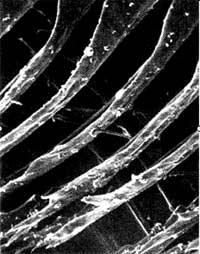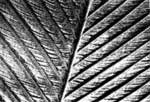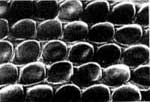Evolutionists maintain that birds evolved from reptiles. However, there are a number of factors which refute this. One of these is the very different surface structures of the two groups.
Birds are covered in feathers, and reptiles with scales. These structures are very different to one another, and there exists not a single fossil specimen to support the claim that feathers evolved from scales.
The Sensitive Design in Feathers
Feathers are “the most complex epidermal appendages found in animals.”(2) Designed with great sensitivity, these structures allow birds to fly, and are highly productive but very light. Moreover, bird wing feathers are themselves “one of the most beautifully designed structures in the world.” From the point of view of their dimensions, form, color and tissue, feathers possess such an enormous variety that few works of art can compare with the color harmony in them.(3)
The famous ornithologist Alan Feduccia describes the design in feathers as follows:
They are lightweight, strong, aerodynamically shaped, and have an intricate structure of barbs and hooks. This structure makes them waterproof, and a quick preen with the beak with the bill will cause flattened feathers to snap into fully aerodynamic shape again. (4)
 |
The microscopic hook system in feathers |
There may be as many as 1 million barbules on a single flight feather of a large bird.(5) The picture to the side shows the tiny hooklets and grooves on the barbules of a feather magnified 20,000 times.(6) Thanks to the design in these hooklets the barbules are able to move away from one another under pressure, and the bird’s wing and feathers are thus prevented from being damaged in high winds.
Evolutionists claim that feathers evolved from the scales on birds’ alleged ancestors—reptiles. The fact is, however, that scales are folds in the skin, whereas feathers emerge from follicles in the skin, in a similar manner to hairs. Feathers consist of barbs, barbules and hook. Furthermore, the places where barbules and scales emerge from are very different.
The Complexity in Feathers
Feathers and other structures comprise the bird’s plumage. The plumage, together with dermal and subdermal muscles, ligaments, the brain and sensory organs, comprises an interconnected structure requiring the functioning of a complex unit, otherwise it will not be possible for the feather to function in a healthy manner. Moreover, with such details as its angle, thickness and shape, the range of variation which can be tolerated in the construction of the feather is very narrow. Even the slightest deviations can render this entire flight system non-functioning. When the follicle structure and complexity are added to this, the scenario of this system coming about by means of evolution becomes totally nonsensical. In fact, even to guess the stages of this imaginary evolution appears impossible.
The difficulty of this is admitted in one evolutionist publication:
The chief difficulty in thinking about the evolution of the first feathers is the difficulty in accounting for the genesis of the structure through a continuous sequence of selective forces and with a continuous series of hypothetical morphological steps* that are functionally plausible. (7)
* Hypothetical morphological steps: Steps presumed to have been taken by feathers during their alleged evolution, structural steps of different appearances.
The following comment appears in another evolutionist publication, “Even speculating on the most primitive stages of the evolution of feathers is very problematic.” (8)
The Irreconcilable Differences between Scales and Feathers
 |
detail of a bird feather |
 |
detail of a reptile scales |
The pictures on the right clearly reveal the differences between scales and feathers. The considerable differences between feathers and scales exist among the genes in which the data for the two structures are coded at the genetic level. This inevitably leads to the question of how, during the alleged transition to birds, and by what mechanism a scale-covered reptile could have acquired the necessary data for the bird feather. According to the theory of evolution, the genetic information for feathers, which did not at that time yet exist in nature, must have been new, and furthermore this information must have been added to the reptile DNA by a natural causes-based mechanism. Evolutionists suggest random mutations for that alleged mechanism. However, it is a known fact that mutations do not add new genetic information to living things, and can therefore have no evolutionary effect. Quite helpless when it comes to proposing a mechanism, evolutionists refuse to abandon their claim, and follow the logic of “It exists, therefore it evolved.” In other words, they blindly defend the idea that feathers evolved from scales.
Evolutionists seek to resolve their dilemma over the evolution of feathers by adding a speculative phase to the scenario. They maintain that feathers first appeared on dinosaurs in such a way as to provide thermal insulation, and that these later evolved and specialized in such a way as to be beneficial for flight. This is yet another of evolutionists’ “Just So Stories.” It is very easy to come up with such tales. First of all the advantage(s) of a given feature of a living thing is described. A scenario is then produced as to how this advantage might have evolved. In practice, of course, there is no limit to the evolutionist theses which can be produced in this way. Like all other “Just So Stories,” this evolutionary tale is unable to provide any answer as to how new genetic information might have emerged.
Another important point on this subject is that the feather structure in flightless birds totally contradicts the claim that the alleged evolution of the feather took place first for thermal insulation and then for flight. When the feathers of flightless birds such as the chicken are examined they are different to the feathers of flying birds. The feathers of flightless birds have a contoured structure rather than the aerodynamic structure in flying birds. These contours resemble the hairs which cover the mammalian body. What needs to be realized about that similarity is that the hairs on mammals regulate thermal insulation in a particularly sound manner.(9) Contoured feathers which make flight impossible will therefore represent an advantage in terms of insulation.
That advantage deals a fatal blow to the evolutionist scenario that the transition to flight took place after thermal insulation. According to that scenario, feathers assumed to have evolved initially for insulation should have a contoured structure, in which case only feathers which provide greater thermal insulation, in other words more contoured feathers, will be selected. For that reason, the hypothetical progress from a contoured structure to an aerodynamic one will be eliminated.
It thus appears that there is no evidence that the feather structure will evolve from thermal insulation to flight. Indeed, it must be thought that the hair-like feathers of flightless birds will work in the exact opposite direction. In short, evolutionists are constructing fantasies, and swimming against the current.
There is also an important biochemical difference between scales and feathers. Both consist of keratin (a kind of protein, the building block of human hair); feathers are made from F-keratin, and scales from a-keratin. However, the biochemical routes of these two types of keratin are very different: A. H. Brush, a foremost authority on the subject, states:
At the morphological level feathers are traditionally considered homologous with reptilian scales. However, in development, morphogenesis (shape/form generation), gene structure, protein shape and sequence, and filament formation and structure, feathers are different. (10)
The Fossil Record Refutes Feather Evolution
The irreconcilable differences between scales and feathers clearly reveal the invalidity of the evolutionists’ claims. In addition, the oldest known bird, Archaeopteryx, has an asymmetrical feather structure identical to that of modern flying birds. In other words, the oldest known bird emerged with the most perfect feather structure, whereas the theory of evolution would expect a “primitive” structure. The researchers L. Martin and S. A. Czerkas state that, “The oldest known feathers … are already modern in form and microscopic detail.” (11)
These words demonstrate that the fossil record invalidates the scenarios of feather evolution. A Columbia University biologist makes the same admission, saying that no transitional form exists between the most primitive feather in our possession and reptilian scales.(12)
Comments from an Aerodynamicist
Dr. Andy McIntosh, a member of the Leeds University academic staff and an expert on aerodynamics, described the superior design in feathers in an interview:
Bird flight in particular is remarkable; consider feathers. If you look at a feather under a microscope, you see the main stem, with barbs coming out to the left and right, and from these you have left-and right-handed barbules. Now the interesting bit is that the left-handed ones have hooks, and the right-handed ones have ridges.
That’s right. The feather is made such that if you bend it, everything bends with it, and yet it’s a very light structure. So the hooks catch the ridges and they slide over the ridges—it’s a mechanical engineer’s dream to have such useful, lightweight engineering. But if you have a sliding joint, you need lubrication. To do this the bird twists its neck around 180º and dips its beak into a tiny oil gland right down at the back of its spine. It then preens itself, wiping this oil all over its feathers, so that they join together nicely, and these sliding joints are oiled. That’s a marvellous bit of engineering.
I have seen a photo in a book, of an aircraft landing at Hong Kong and underneath it is a falcon landing at the same time. Now as you look at birds and planes together, are you going to say that one is designed and the other isn’t? I would find that scientifically preposterous.(13)
Another Major Blow to the Bird Evolution Scenario: Peacock Feathers
Another important example to reveal the invalidity of the scenarios of bird evolution is the peacock feather. The design which gives these creatures their wonderful colors and patterns points to intelligent design, as it is both most aesthetically pleasing and exceedingly complex. That explains why when Charles Darwin saw the beauty-filled design in peacock feathers he realized he was looking at the inconsistency of his own theory, and admitted, “The sight of a feather in a peacock"s tail, whenever I gaze at it, makes me sick!” (14)
There are geometrical designs in the peacock feather which are based on mathematical equations. One astonishing feature of the wondrous colors in these feathers, which change according to the angle of light reflection, is that they are not based on pigments. Researchers who have studies this design have revealed that the layers of the feathers are very carefully designed and that the structure which gives rise to the pattern is irreducibly complex. Such a feather design cannot, of course, be explained in terms of imaginary processes based on natural causes, and demonstrates the invalidity of Darwinism.
Conclusion:
There are major anatomical differences between living birds and living reptiles, their alleged ancestors. Robert Caroll, a world expert of vertebrate paleontology, says the following on the subject:
Birds are ‘the most clearly distinct of vertebrate classes’ and there’s an enormous gap in anatomy, and way of life between birds and their putative closest relatives, reptiles.(15)
These words are an important admission. They refute the evolutionist thesis that there was evolution between the two groups, either in the fossil record or among living specimens.
Evolutionists support scenarios of bird evolution not because they are a consistent thesis based on scientific evidence, but as a dogma adopted for philosophical reasons. There is only one explanation for the complex design in bird feathers and the absence in the fossil record of any specimen which might represent support for evolution. Birds did not evolve, but were intelligently brought into being. In other words, they were created. There is no doubt that God, the all-knowing and Almighty, created the perfect structures in birds and their flying abilities.
The ability to fly given to birds by God is revealed in one verse of the Qur’an as follows:
""Do they not see the birds suspended in mid-air up in the sky? Nothing holds them there except God. There are certainly Signs in that for people who believe."" (Qur’an, 16:79)
1 Jonathan D. Sarfati, Refuting Evolution, Chapter 4; Dr. Jerry Bergman, "The Evolution of Feathers: A Major Problem for Darwinism", Technical Journal 17(1), 2003, pp. 33-41
2 R. O. Prum, and S. Williamson, “Theory of the Growth and Evolution of Feather Shape”, Journal of Experimental Zoology (Molecular Developmental Evolution) 291: 30-57, 2001
3 R. O. Prum, and S. Williamson, “Theory of the Growth and Evolution of Feather Shape”, Journal of Experimental Zoology (Molecular Developmental Evolution) 291: 30-57, 2001
4 A. Feduccia, The Origin and Evolution of Birds (New Haven, CT: Yale University Press, 1996), p. 130
5 Michael Denton, Evolution: A Theory in Crisis, Adler and Adler, Bethesda, p. 202, 1986
6 Photos: courtesy of David Menton
7 P. Regal, “The Evolutionary origin of Feathers”, The Quarterly Review of Biology, 50(1): 35-66, 1975:pp. 35-36
8 W. J. Bock, “Explanatory History of the Origin of Feathers”, American Zoologist, 40: 478-485
9 A. Feduccia, The Origin and Evolution of Birds (New Haven, CT: Yale University Press, 1996), p. 130.
10 A. H. Brush, "On the Origin of Feathers," Journal of Evolutionary Biology, 9:131-142, 1996
11 L. Martin, and S. A. Czerkas, “The Fossil Record of Feather Evolution in the Mesozoic”, American Zoologist, 40: 687-694, 2000; p. 687
12 W. J. Bock, “Explanatory History of the Origin of Feathers”, American Zoologist, 40: 480
13“Flying High”, An interview with Dr. Andy McIntosh, http://www.answersingenesis.org/home/area/magazines/docs/v20n2_mcintosh.asp
14 F. Darwin, (Ed), Letter to Asa Gray, dated 3 April 1860, The Life and Letters of Charles Darwin, John Murray, London, Vol. 2, pp. 296, 1887; 1911 Edition, D. Appleton and Company, New York and London, Vol. 2, pp. 90–91
15 R. Caroll, Patterns and Processes of Vertebrate Evolution, Cambridge University Press, New York, 1997 p. 306


